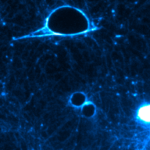Link to Pubmed [PMID] – 8847278
J. Appl. Physiol. 1995 Dec;79(6):2094-100
The contraction elicited by angiotensin II (ANG II) was studied by using standard isometric tension techniques in aortic rings exposed for 1 h to 1 or 10 micrograms/ml Escherichia coli lipopolysaccharide endotoxin (LPS). This contraction was 18 and 71% greater for the two doses of LPS, respectively, than in unexposed control rings. In endothelium-denuded rings, the LPS-induced increase in contraction in response to ANG II was completely abolished. Because the contraction induced by ANG II is modulated by the simultaneous release of prostaglandins, we tested the hypothesis that LPS interferes with this modulation. We found that the LPS-induced increase in contraction to ANG II was inhibited in the presence of the cyclooxygenase inhibitor indomethacin (10(-5) M) or the prostaglandin H2/thromboxane A2-receptor antagonist SQ-29548 (2 x 10(-7) M). Conversely, the LPS-induced increase in contraction in response to ANG II was not inhibited by the presence of dexamethasone (10(-6) M), which inhibits new protein synthesis. In addition, there was no loss of vasodilator response to the endothelium-dependent receptor agonist acetylcholine (10(-8)-10(-4) M) or in the constrictor responses to norepinephrine (10(-9)-10(-5) M) and KCl (20-100 mM). We conclude that short exposure to LPS produces a specific increase in the constrictor response to ANG II via mechanisms mediated by prostaglandin H2/thromboxane A2. This effect could be a LPS-induced shift in favor of constrictor prostanoids in the balance of dilator/constrictor prostanoids, the release of which is associated with stimulation by ANG II.
